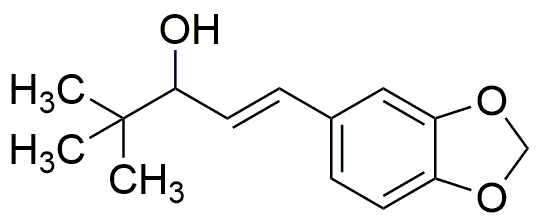Stiripentol is widely utilized in research focused on:
- Epilepsy Treatment: Primarily used as an adjunctive therapy for patients with Dravet syndrome, a severe form of epilepsy, helping to reduce the frequency of seizures.
- Pharmaceutical Development: Employed in the formulation of new medications, particularly in combination therapies, to enhance efficacy and patient outcomes in epilepsy management.
- Neuroscience Research: Investigated for its neuroprotective properties, contributing to studies on brain health and potential applications in other neurological disorders.
- Drug Interaction Studies: Used in research to understand how it interacts with other antiepileptic drugs, aiding in the development of safer and more effective treatment regimens.
- Clinical Trials: Involved in various clinical studies to assess its long-term effects and benefits, providing valuable data for healthcare professionals and researchers.
Informations générales
Propriétés
Sécurité et réglementation
Applications
Stiripentol is widely utilized in research focused on:
- Epilepsy Treatment: Primarily used as an adjunctive therapy for patients with Dravet syndrome, a severe form of epilepsy, helping to reduce the frequency of seizures.
- Pharmaceutical Development: Employed in the formulation of new medications, particularly in combination therapies, to enhance efficacy and patient outcomes in epilepsy management.
- Neuroscience Research: Investigated for its neuroprotective properties, contributing to studies on brain health and potential applications in other neurological disorders.
- Drug Interaction Studies: Used in research to understand how it interacts with other antiepileptic drugs, aiding in the development of safer and more effective treatment regimens.
- Clinical Trials: Involved in various clinical studies to assess its long-term effects and benefits, providing valuable data for healthcare professionals and researchers.
Documents
Fiches de données de sécurité (FDS)
La FDS fournit des informations de sécurité complètes sur la manipulation, le stockage et l’élimination du produit.
Spécifications du produit (PS)
Le PS fournit une description complète des propriétés du produit, notamment sa composition chimique, son état physique, sa pureté et les exigences de stockage. Il détaille également les plages de qualité acceptables et les applications prévues du produit.
Certificats d'analyse (COA)
Recherchez des certificats d'analyse (COA) en saisissant le numéro de lot du produit. Les numéros de lot et de lot se trouvent sur l'étiquette d'un produit, après les mots « Lot » ou « Lot de fabrication ».
Numéro de catalogue
Numéro de lot/série
Certificats d'origine (COO)
Ce certificat d'exploitation confirme le pays dans lequel le produit a été fabriqué, et détaille également les matériaux et composants utilisés et s'il est issu de sources naturelles, synthétiques ou autres sources spécifiques. Ce certificat peut être requis pour les douanes, le commerce et la conformité réglementaire.
Numéro de catalogue
Numéro de lot/série
Fiches de données de sécurité (FDS)
La FDS fournit des informations de sécurité complètes sur la manipulation, le stockage et l’élimination du produit.
DownloadSpécifications du produit (PS)
Le PS fournit une description complète des propriétés du produit, notamment sa composition chimique, son état physique, sa pureté et les exigences de stockage. Il détaille également les plages de qualité acceptables et les applications prévues du produit.
DownloadCertificats d'analyse (COA)
Recherchez des certificats d'analyse (COA) en saisissant le numéro de lot du produit. Les numéros de lot et de lot se trouvent sur l'étiquette d'un produit, après les mots « Lot » ou « Lot de fabrication ».
Numéro de catalogue
Numéro de lot/série
Certificats d'origine (COO)
Ce certificat d'exploitation confirme le pays dans lequel le produit a été fabriqué, et détaille également les matériaux et composants utilisés et s'il est issu de sources naturelles, synthétiques ou autres sources spécifiques. Ce certificat peut être requis pour les douanes, le commerce et la conformité réglementaire.

